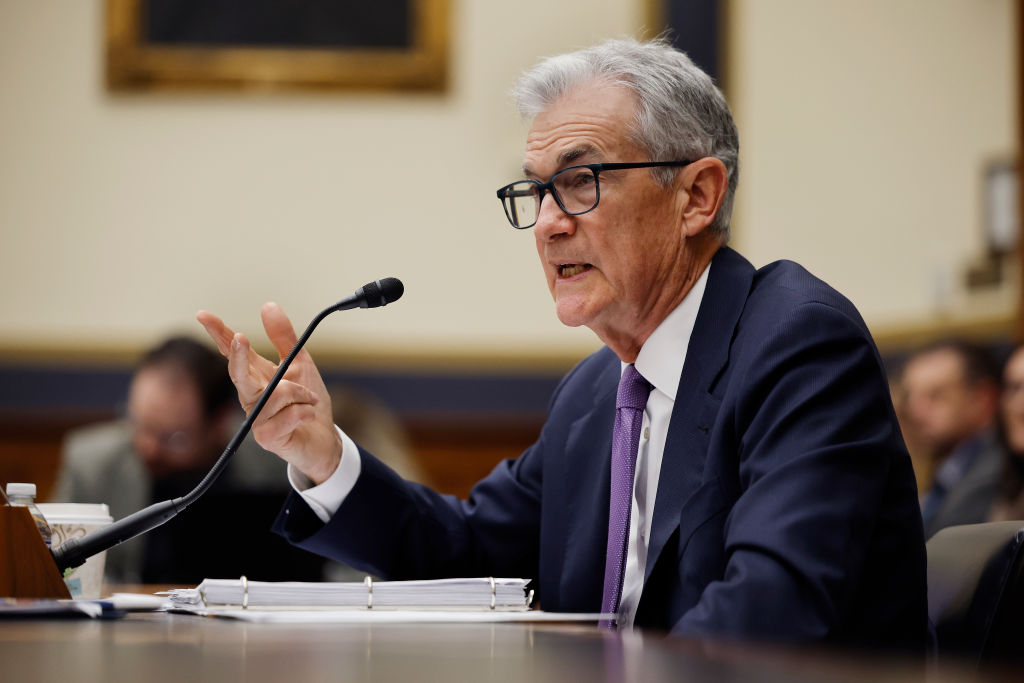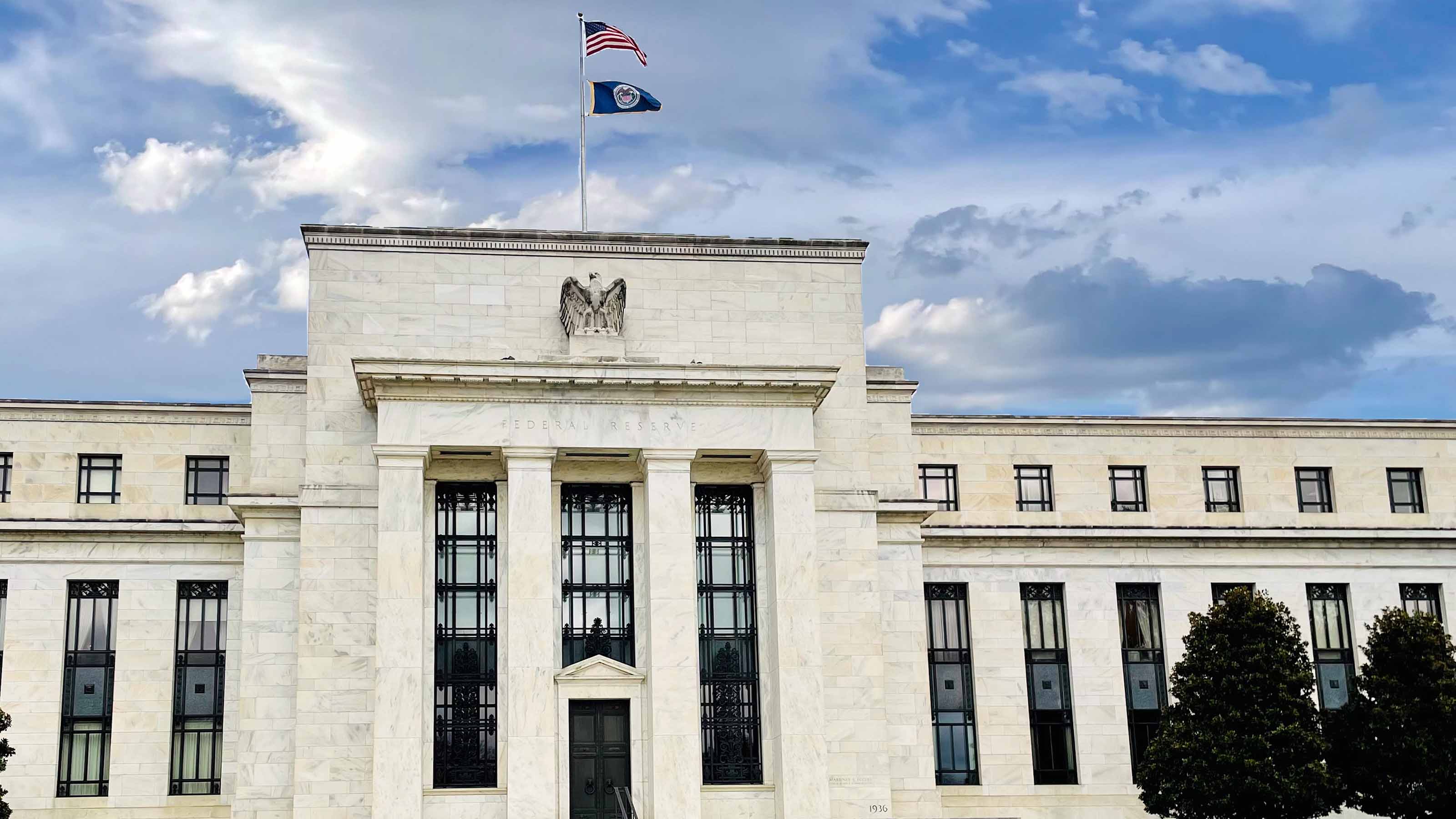Fed Holds Rates Steady, Eyes Three Cuts in 2024: What the Experts Are Saying
The Federal Reserve left interest rates unchanged at a 23-year high, but it's still penciling in three rate cuts this year.


The Federal Reserve made the widely expected move of keeping interest rates unchanged when it wrapped up its regularly scheduled policy meeting Wednesday. Equally important, the central bank continued to pencil in three quarter-point interest rate cuts in 2024.
The Fed's Federal Open Market Committee (FOMC) left the short-term federal funds rate steady at a 23-year high of 5.25% to 5.5%. But what market participants really want to know is when the Fed is going to begin easing.
A recent string of sticky inflation data had some market participants beginning to question the Fed's timing and number of rate cuts planned for this year. But the release of the Fed's Summary of Economic Projections (SEP), or dot plot, showed the central bank remains on track for the expected three rate cuts.
From just $107.88 $24.99 for Kiplinger Personal Finance
Be a smarter, better informed investor.

Sign up for Kiplinger’s Free Newsletters
Profit and prosper with the best of expert advice on investing, taxes, retirement, personal finance and more - straight to your e-mail.
Profit and prosper with the best of expert advice - straight to your e-mail.
That said, the data-dependent Fed now sees a shallower path down to its 2% inflation target.
"We had some inflation bumps this year but Jerome Powell's not blinking," says David Russell, global head of market strategy at TradeStation. "Investors are relieved to see three cuts stay in the dot plot, supporting markets and risk appetite."
Interest rate traders now assign a 70% probability to the FOMC enacting its first quarter-point rate cut in June, up from 56% a day ago, according to CME Group's FedWatch Tool.
With the FOMC's latest rate decision now a matter of record, we turned to economists, strategists, investment officers and other pros for their thoughts on what the move means for markets, macroeconomics and monetary policy going forward. Please see a selection of their commentary, sometimes edited for brevity or clarity, below.
Interest rates: the experts weigh in

"In one line: Still three cuts and recent inflation data are viewed as an interruption, not a trend. Overall, though, the FOMC has stuck to its view that the underlying inflation picture is improving, notwithstanding the disappointing numbers in the past two months. These numbers have raised the base so policymakers have lifted their Q4 2024 forecast for core PCE to 2.6% from 2.4%, but – importantly – they have left the 2025 and 2026 numbers unchanged at 2.2% and 2.0%, respectively. In other words, they view the most recent numbers as a temporary interruption rather than a change in the trend." – Ian Shepherdson, chairman and chief economist at Pantheon Macroeconomics
"There was little surprise on Wednesday when the Federal Reserve announced that it would hold rates where they've been since July, and markets are still projecting that rate cuts will begin this summer. However, there are still potential risks ahead and a 'soft landing' is by no means a certainty. The bottom line is that it's important to be ready for everything. Economic activity can weaken very quickly. The Fed needs to be nimble: they currently can afford to be patient given the still-tight labor market and strong gross domestic product (GDP) data – but be on guard for sudden changes." – Brian Henderson, chief investment officer at BOK Financial
"Despite projections of stronger growth, lower unemployment, and slightly higher core PCE inflation, policymakers still anticipate three rate cuts this year. We continue to expect that inflation progress over the past year and disinflationary signals, such as rebalancing in labor, goods and rental markets, will lead the Fed to begin its cutting cycle this summer. The slight rise in the longer-run policy rate forecast is both negligible and noteworthy. It is negligible because market expectations are already much higher, but noteworthy as it reinforces the market's recent perception that the rate-cutting cycle may be shallower than initially anticipated. Overall, despite recent bumps in the inflation road, major central banks remain on track for rate cuts in the coming months and high-quality fixed income bonds stand to benefit." – Whitney Watson, global co-head and co-chief investment officer of fixed income and liquidity solutions within Goldman Sachs Asset Management
"The Fed left rates unchanged, and importantly, left in place their projection of three rate cuts in 2024. The details are quite dovish, because they're leaving rate cuts on the table even while projecting slightly higher inflation and more economic growth. They now expect 2.6% core PCE inflation in 2024, up from 2.4%. Expected GDP growth for 2024 was upgraded to 2.1% from 1.4%. There was slightly more hawkishness looking further out into 2025 and beyond, with fewer rate cuts in 2025 and a slightly higher long-run rate of 2.6% (versus 2.5% before). However, this was because they expect a much stronger economy going forward. In summary, the Fed is projecting a stronger economy over the next few years while still penciling in normalization of rates, i.e. cuts. That's bullish, especially because higher nominal growth (GDP + inflation) means more profit growth even as rates fall." – Sonu Varghese, global macro strategist at Carson Group
"The Summary of Economic Projections (SEP) had higher economic growth, lower unemployment, and slightly higher inflation during 2024 than previously estimated after the release of the December 2023 SEP. This means that the Fed has not been spooked by higher growth and it is, at this time, not affecting its achievement of the 2% inflation target over the long run, which it continued to estimate will be achieved in 2026. This means that the Fed has taken one potential rate cut off the table in 2025 compared to what it had estimated in the December 2023 SEP. The long-run federal funds rate moved slightly higher, from 2.5% to 2.6%, as there were more ‘dots’ at 3.0% than there had been in the December 2023 SEP. We were concerned with the slow pace of inflation target conversion and the effects it could have had on Fed officials, but although it is clear that this has changed the Fed’s view of rates in 2025 and 2026, it did not affect its short-term federal funds rate expectations." – Eugenio Alemán, chief economist, and Giampiero Fuentes, economist, at Raymond James
"The Fed and market expectations were in lockstep today with no change to the federal funds rate. Federal Reserve Chair Powell again emphasized they want to gain greater confidence that inflation is moving toward its 2% goal. Market forecasters have recently moved towards the Fed's December 2023 expectations of three cuts this year. Many had six cuts estimated for 2024. I would not be surprised however, that the Fed moves to forecasting fewer than three cuts in the coming weeks leaving the market to play catch up again due to economic growth, employment and inflation all being stronger than expected." – David Merrell, founder and managing member at TBH Advisors
"With the Fed leaving rates unchanged, as most expected they would, the more important incremental information will be Chair Powell's forward looking comments. Recently strong economic data, including employment, commodity strength, and a potential recovery in corporate earnings, all suggest the Fed will maintain a very measured approach to future rate cuts. Also, as students of history, the Fed is very likely aware that sudden surges in inflation have typically happened in waves of two or three, meaning once inflation cools after the first surge, the tendency has been for inflation to surge once again." – David Lundgren, chief market strategist and portfolio manager at Little Harbor Advisors
"As expected, the U.S. Federal Reserve kept rates unchanged, with the Fed Funds target range at 5.25 to 5.5% following a meeting that was heavily focused on the Fed's dot plots and Summary of Economic Projections (SEP). The FOMC median forecast shows 75 basis points of rate cuts for 2024, in line with their former dot plot projections made in January and, importantly, in line with current market expectations. The Fed reiterated that they need to see greater confidence on the disinflation trend. The dot plots look fairly dovish and the market impact reflects that. Our expectations are that the first rate cut would occur in June." – Rajeev Sharma, managing director of fixed income investments at Key Private Bank
"The Fed's decision to maintain interest rates at present levels was not a surprise due to continued persistence within inflation due to housing and core services, as well as positive labor market data which proved greater tolerance within the economy for its wait-and-see approach. The committee's latest dot plot affirms that most members still support three rate cuts amounting to 75 basis points this year, but upward revisions to inflation suggest members are under no illusion that prices will trend at or near optimal levels before loosening rates. Furthermore, downward revisions to growth suggest the committee is anticipating the possibility for economic distress to hasten a premature or deeper rate cut." – Noah Yosif, chief economist at the American Staffing Association
"The FOMC was on the horns of a dilemma. January and February's inflation readings showed that progress towards the Fed's 2% target is stagnating at best and inflecting back up at worst. The facts called for a hawkish adjustment to reflect the slackening progress. Instead, we got a dovish adrenaline shot- reaffirming the November pivot. The boost to financial conditions is working counter to the Fed's price mandate. So much for Jay Powell's presumed admiration for Paul Volcker." – Brad Conger, chief investment officer at Hirtle Callaghan & Co.
Related Content
Profit and prosper with the best of Kiplinger's advice on investing, taxes, retirement, personal finance and much more. Delivered daily. Enter your email in the box and click Sign Me Up.

Dan Burrows is Kiplinger's senior investing writer, having joined the publication full time in 2016.
A long-time financial journalist, Dan is a veteran of MarketWatch, CBS MoneyWatch, SmartMoney, InvestorPlace, DailyFinance and other tier 1 national publications. He has written for The Wall Street Journal, Bloomberg and Consumer Reports and his stories have appeared in the New York Daily News, the San Jose Mercury News and Investor's Business Daily, among many other outlets. As a senior writer at AOL's DailyFinance, Dan reported market news from the floor of the New York Stock Exchange.
Once upon a time – before his days as a financial reporter and assistant financial editor at legendary fashion trade paper Women's Wear Daily – Dan worked for Spy magazine, scribbled away at Time Inc. and contributed to Maxim magazine back when lad mags were a thing. He's also written for Esquire magazine's Dubious Achievements Awards.
In his current role at Kiplinger, Dan writes about markets and macroeconomics.
Dan holds a bachelor's degree from Oberlin College and a master's degree from Columbia University.
Disclosure: Dan does not trade individual stocks or securities. He is eternally long the U.S equity market, primarily through tax-advantaged accounts.
-
 How to Choose the Best Charities to Donate To
How to Choose the Best Charities to Donate ToWhile you set your giving strategy, think about your values, and select organizations that will put your contributions to good use.
-
 I'm 62 and want to work a few more years, but all of this AI talk makes me feel like a dinosaur. Can't I just do my job without technology complicating things?
I'm 62 and want to work a few more years, but all of this AI talk makes me feel like a dinosaur. Can't I just do my job without technology complicating things?We asked professional career coaches for advice.